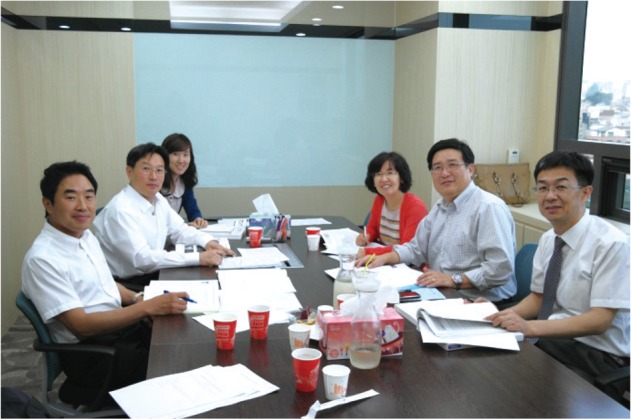INTRODUCTION
INTERNATIONAL DIGESTIVE ENDOSCOPY NETWORK (IDEN): THE PAST AND PRESENT
Rapid advances in gastrointestinal (GI) endoscopy have made it necessary for us to continue to equip ourselves with latest endoscopic technologies and techniques in various fields. In 2011, IDEN took its first step toward sharing the latest researches, skills and technologies on diverse topics of endoscopy in the upper and lower GI, including colonoscopy, enteroscopy, and endoscopic mucosal resection/endoscopic submucosal dissection (IDEN 2011 July 1 to 2, 2011, Grand Hilton Hotel Convention Center, Seoul, Korea). This year, IDEN was held at the same venue on June 9 to 10, 2012 with 2 days of impressive scientific programs dealing with a wide variety of concerns covering from the upper and lower GI to pancreatobiliary endoscopies. Some of the most outstanding leaders in their fields were invited from Asia Pacific, USA, and Europe. IDEN was designed to have participants get an opportunity to explore and discuss a variety of issues in basic and clinical research to endoscopy, gastroenterology and other various clinical problems we can share, forming "the NETWOKS" for tomorrow. IDEN 2011 was first inaugurated by Prof. Chang Duck Kim (Korea University Anam Hospital, Seoul, Korea) successfully, and Prof. Myung-Hwan Kim (Seoul Asan Hospital, University of Ulsan, Seoul, Korea) and Prof. Young-Tae Kim (Korea University Guro Hospital, Seoul, Korea) served as a chairman and congress president of IDEN 2012, respectively, to extend IDEN fruitfully as a root of bigger international networking in the field of digestive endoscopy.
THE REAL INTERNATIONAL NETWORK: WHY IS IT NEEDED?
Endoscopic developments offer enormous potential for the diagnosis and treatment of a wide range of GI diseases and difficult conditions. Despite excitement over such advances, there are still challenges in determining criteria for application of those new technologies and guidelines for effective clinical use. For instances, endoscopic mucosal dissections (ESD) and pure natural orifice transluminal endoscopic surgery1 (NOTES) confronted regulatory challenges because standard endoscopic treatments can't handle the complexity and diversity of merits these technologies can provide. As a result, consensus is made on the basis of unclear and ambiguous barriers for these advancements. In order to better understand and define the barriers, we sought feedback from stakeholders regarding areas of uncertainty or concerns about these therapies, and the results are summarized and discussed in this special issue. Identifying challenges would be the stepping stone for providing higher solutions for digestive endoscopy, which is why a network is prerequisite. As much as networking is concerned, telemedicine is a convenient and efficient tool for remote education purpose in various fields, and it can also be used to educate doctors and medical students. Prof. Joon Soo Hahm, MD (Hanyang University College of Medicine, Seoul, Korea), the former chairman of Korea Society of Gastrointestinal Endoscopy, established the effectiveness of the telemedical system for live endoscopic multichannel demonstration conference by demonstrating the effectiveness and usefulness of a multicenter-based live endoscopic demonstration through live, interactive, high resolution video transmission using advanced networks and the digital video transport system (DVTS) and concluded that a multicenter-based live endoscopic demonstration is a very effective conferencing method when used with advanced networks and DVTS.2,3 A social network is a social structure made of a set of entities (such as individuals or organizations) and the dyadic ties between these entities, of which perspective provides a clear way of analyzing the structure of the whole social entities. The study of these structures uses social network analysis to identify local and global patterns, to locate influential entities, and to examine network dynamics. In a similar way, endoscopic network is also an inherently interdisciplinary academic field emerged from endoscopic diagnosis, endoscopic treatment as well as endoscopy related instrumental development, forming "web of endoscopic group."
CONCLUSION
IDEN 2012 AND IDEN 2013
In this special issue, among 112 lectures delivered during June 9 to 10, 2012, the editorial members selected outstanding articles submitted before and during IDEN following peer review process. Prof. Il Ju Choi contributed to session 1 (upper gut), Prof. Kwang An Kwon session 2 (lower gut), Prof. Seok Ho Dong session 3 (Pancreatobiliary), and Prof. Eun Young Kim session 4 (Endoscopic Ultrasound) (Fig. 1). More than 800 participants and more than 150 faculties from 16 countries created wonderful network environment of digestive endoscopy. IDEN 2013 will be held in June 8 to 9, 2013 at Grand Hilton Hotel Convention Center, Seoul, Korea, and the organizing procedure will be started from November 2012. In a similar fashion with IDEN 2012, a special issue of Clinical Endoscopy will be shared during the next conference.







